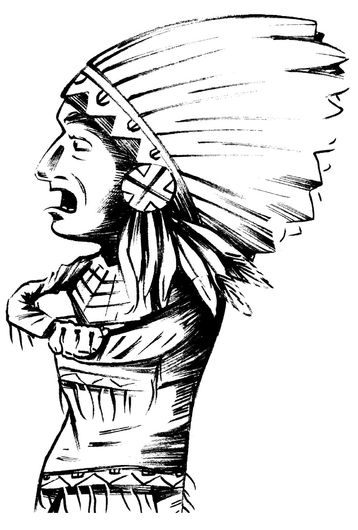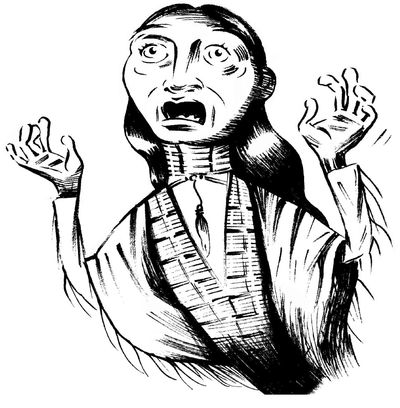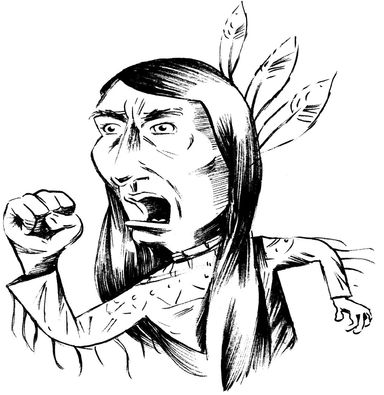Which Way to the Wild West? (12 page)
Read Which Way to the Wild West? Online
Authors: Steve Sheinkin

J
udah may have rested, but the race he had started was just beginning. For a race, it was off to a pretty slow start.
udah may have rested, but the race he had started was just beginning. For a race, it was off to a pretty slow start.
When work began in Sacramento, people gathered to cheer and wave signs that said things like “Little Indian Boy, Step Out of the Way of the Big Engine.” This cruel motto captured the mood. Americans sensed that this railroad was going to change the country forever. Assuming it could actually be built, that is. There were no factories in California yet. So the Central Pacific had to get nearly all of its supplies shipped from the East: locomotives, train cars, iron rails, even the nails.
Collis Huntington had the job of buying supplies in New York City and shipping them to his partners in California. One of the Big Four, Huntington really
was
big: over six feet tall and 250 pounds. (His son, he bragged, was even bigger: “My son weighs 275 pounds; my son is sixteen.”)
was
big: over six feet tall and 250 pounds. (His son, he bragged, was even bigger: “My son weighs 275 pounds; my son is sixteen.”)
His attitude was big too. It had to be. He often bought supplies for the railroad with no idea how he was going to pay for them. “I have gone to sleep at night in New York,” he said, “when I had a million and a half dollars to be paid by three o'clock on the following day, without knowing where the money was coming fromâand slept soundly.”
That's the attitude you need to take on a project this huge. You also need people to do the actual work. That was becoming a problem. When the Central Pacific advertised for five thousand workers, only eight hundred showed up. After a couple weeks of swinging picks and shovels, many of the men collected their pay and quit to try for easier earnings in the gold mines.
Meanwhile, across the West in Nebraska, the Union Pacific was moving only a tiny bit fasterâlaying just twenty miles of track by
1864. Like Central Pacific, the UP had a hard time finding workers. (A little something called the Civil War was going on back east. That kept a few million American men busy.)
1864. Like Central Pacific, the UP had a hard time finding workers. (A little something called the Civil War was going on back east. That kept a few million American men busy.)
The UP was about to face another problem, as a young engineer named James Evans realized while planning the railroad's route through western Nebras Evans watched a group of Lako warriors ride up to his crew. Th chief got right to the point:
“I do not like the idea of your coming here. This is the
Indian's country.”

That pretty much sums up the troubleâthe planned route of the Union Pacific sliced through hundreds of miles of Plains Indians' land. These nations had horses and guns, and thousands of young men who knew how to use them. No wonder government leaders worried about what they called the “Indian Problem.”
T
his was not a new problem. Since the days of the Oregon Trail, settlers, miners, and stagecoaches had been cutting across Plains Indians' land. These travelers brought new diseases and shot buffalo, which the Indians depended on for food. Violent clashes between settlers and Indians became more and more common.
his was not a new problem. Since the days of the Oregon Trail, settlers, miners, and stagecoaches had been cutting across Plains Indians' land. These travelers brought new diseases and shot buffalo, which the Indians depended on for food. Violent clashes between settlers and Indians became more and more common.
And now, just as the railroad workers were arriving, the fighting exploded to a whole new level. In the summer of 1864, a group of Indian warriors killed a family of four in Colorado. Furious settlers brought the bodies into Denver and put them on display. “Everybody saw them,” said one Denver resident, “and anger and revenge mounted all day long as the people filed past.”
“I determined to strike a blow against this savage and determined foe,” declared John Chivington, an American army officer.
Just before sunrise on November 29, Chivington led seven hundred soldiers toward a Cheyenne camp on the banks of Sand Creek. In the camp were about six hundred Indians, most of them women and children.
“Kill and scalp all, big and little,” Colonel Chivington told his men.
A young officer objected. “It would be murder in every sense of the word,” he said, arguing that the people in this camp had nothing to do with recent attacks on white settlers.
“I have come to kill Indians,” Chivington insisted.
“I
was still in bed when I heard shouts and the noise of people running about the camp,” George Bent later reported.
was still in bed when I heard shouts and the noise of people running about the camp,” George Bent later reported.
The son of a Cheyenne mother and white father, Bent was living with the Cheyenne at Sand Creek when Chivington's soldiers attacked. He jumped up and scrambled out of his tent. “All was confusion and noise,” he said. “Men, women, and children rushing out of the lodges partly dressed.”
Hundreds of Americans soldiers were charging into camp from several directions. “Remember the murdered women and children!” Chivington shouted. “Take no prisoners!”
The Indian men dove back into their tents to get their guns and bows. A young Cheyenne named Little Bear said the bullets smacking his tent sounded “like big hailstones.”
George Bent grabbed his rifle and ran out to join the fight. But the Cheyenne fighters were nearly surrounded by American soldiers and were slowly driven out of their camp. “I was struck in the hip by a bullet and knocked down,” Bent said.
With the help of friends, Bent made it to another Cheyenne camp nearby. Other survivors from the Sand Creek battle also gathered there. “Everyone was crying,” said Bent, “even the warriors, and the women and children screaming and wailing. Nearly everyone present had lost some relatives or friends.”

What exactly happened at Sand Creek? John Chivington reported that he had attacked a village that had nine hundred to one thousand Cheyenne warriors. He said it was a fierce battle between American and Cheyenne soldiers, and that “between five hundred and six hundred Indians were left dead upon the ground.”
Other witnessesâboth American and Cheyenneâsaid they saw about 160 Cheyenne dead, including about 100 women and children. An army officer named James Conner described the fight as more massacre than battle. He said he saw U.S. soldiers killing women and children, cutting off their scalps and slicing up their bodies “in the most horrible manner.”
A committee in Congress investigated the incident and concluded that something horrible had happened at Sand Creek. “As to Colonel Chivington,” the members of Congress reported, “our committee can hardly find fitting terms to describe his conduct. Wearing the uniform of the United States ⦠he deliberately planned and executed a foul and dastardly massacre.”
Chivington retired from the army and was never punished. For the rest of his life he denied having killed women and children. “I stand by Sand Creek,” he maintained.
But the Cheyenne told their own story of what they called the Sand Creek Massacre. The news sped across the Great Plains. Arapaho and Lakota warriors banded together with the Cheyenne in calls for revenge. “This was an uncommon thing, to begin a war in the dead of winter,” said George Bent, “but the Cheyennes were very mad and would not wait.”
Working in small, fast-riding groups, Indian fighters attacked stagecoaches, yanked down telegraph wires, and burned ranches all
over Colorado. Early in 1865 a thousand Plains warriors attacked the town of Julesburg, Colorado, burning every building to the ground.
over Colorado. Early in 1865 a thousand Plains warriors attacked the town of Julesburg, Colorado, burning every building to the ground.
Even this didn't prevent settlers from coming west. Not when there was gold to be found.
I
n August 1865 a Lakota chief named Red Cloud was camped near the Powder River in Montana. Hunters raced into camp with startling news: American settlers were pouring onto Lakota land! Miners had found gold in Montana and were now carving a wagon road right through Lakota hunting grounds.
n August 1865 a Lakota chief named Red Cloud was camped near the Powder River in Montana. Hunters raced into camp with startling news: American settlers were pouring onto Lakota land! Miners had found gold in Montana and were now carving a wagon road right through Lakota hunting grounds.
“The white men have crowded the Indians back year by year,” Red Cloud protested. He had this warning for the American “Great Father” (president, that is):
“If the Great Father kept white men out of my country, then peace would last forever. The Great Spirit has raised me in this land and has raised you in another land. What I have said I mean. I mean to keep this land.”
Red Cloud

Government leaders believed him. And they badly wanted to keep war from spreading all over the Great Plains. But they badly wanted gold too. So in June 1866 they invited Red Cloud to a meeting at Fort Laramie, in what is now Wyoming. The government offer was this: we pay you money and you let American miners use the road through your land.
Red Cloud and the other Lakota didn't have time to respond. While the chiefs were still talking the offer over, seven hundred American soldiers showed up with orders to guard the road through Lakota land! “The Great Father sends us presents and wants us to sell him the road,” shouted a fuming Red Cloud. “But the white chief goes with soldiers to steal the road before the Indians say yes or no!”
The Lakota chiefs stormed out of the meeting. And the American soldiers quickly chopped down trees and hammered together log forts along the miners' roadâthe Bozeman Trail, as it came to be known. This ignited a conflict called Red Cloud's War, as bands of Lakota warriors attacked travelers and soldiers along the road.
The soldiers were supposed to be guarding the road. But they were so badly outnumbered, they spent most of their time shivering in their forts (and eating their horses as the food ran out).
At Fort Phil Kearny an American officer named William Fetterman got sick of sitting around. Fetterman didn't respect Indians as soldiers. He was sure he could end the whole war with one bold attack. “Give me eighty men,” he boasted, “and I would ride through the whole Sioux nation.”
On a freezing morning in December 1866, Fetterman got his chance.
“I
was sixteen years old when this happened,” remembered a Lakota fighter named Fire Thunder. The respected warrior Crazy Horse set up the strategy. He knew that the Americans in Fort Phil Kearny must be getting low on firewood. He hid Fire Thunder and more than a thousand other Lakota, Cheyenne, and Arapaho warriors behind a nearby hill. He told them what to do. Then he waited.
was sixteen years old when this happened,” remembered a Lakota fighter named Fire Thunder. The respected warrior Crazy Horse set up the strategy. He knew that the Americans in Fort Phil Kearny must be getting low on firewood. He hid Fire Thunder and more than a thousand other Lakota, Cheyenne, and Arapaho warriors behind a nearby hill. He told them what to do. Then he waited.
As expected, a group of soldiers came out of the fort to cut wood. Crazy Horse attacked the woodcutters with a small group of warriors. The soldiers blasted buglesâa signal for help. William Fetterman charged out of the fort with (coincidentally) eighty soldiers.
Crazy Horse retreated to the top of a hill, trying to tempt Fetterman into attacking him. He taunted Fetterman by calmly walking around on the hill while Fetterman's soldiers fired at him. He even got off his horse and casually adjusted the saddle.
Fetterman couldn't take it anymore. He led his men on a charge up the hillâand right into Crazy Horse's trap.
“When they came to the bottom of the hill, the fighting began all at once,” Fire Thunder said. In less than thirty minutes of brutal combat, Fetterman and all his men were killed. About two hundred Indian fighters were killed or wounded as well.
Fire Thunder was stunned by the scene: dead men and horses lying everywhere, frozen pools of blood all over the mud and snow.
When they heard about the Fetterman Fight, Americans were stunned too. This was the biggest battle American soldiers had ever fought with Indians, and it was a disastrous defeat.
The government tried again to talk peace with the Lakota chiefs. Red Cloud's position remained firm: no peace until settlers and soldiers
left Lakota land. “When we see the soldiers moving away and the forts abandoned, then I will come and talk,” Red Cloud said.
left Lakota land. “When we see the soldiers moving away and the forts abandoned, then I will come and talk,” Red Cloud said.
Other books
The Girl With Death Breath and Other Naughty Stories for Good Boys and Girls by Christopher Milne
House of Cards by W. J. May, Chelsa Jillard, Book Cover By Design
Lake Charles by Lynskey, Ed
The Inferior by Peadar O. Guilin
Quarterback Bait by Celia Loren
A Man to Die for by Eileen Dreyer
Stardust by Rue Volley
Tears of the Renegade by Linda Howard
An Unfinished Life by Wasowski, Mary